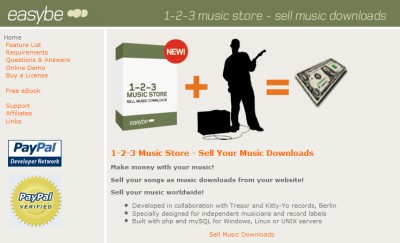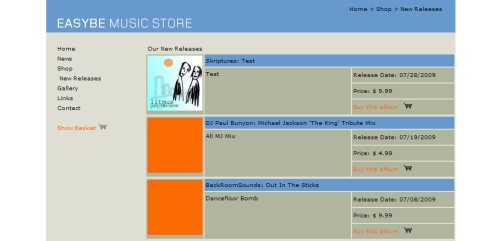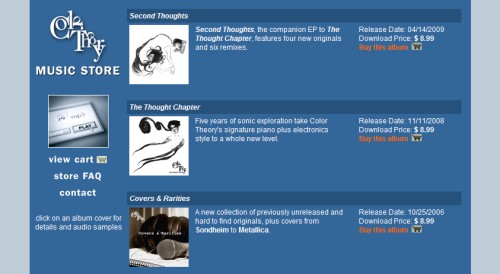
I get at least one phone call per week asking about my experience with the 1-2-3 Music Store, a server script I’ve been running for three years. It allows me to sell mp3 downloads direct from my web site, with no middleman. Put simply, the 1-2-3 Music Store is the ugly stepsister of the iTunes Store. She may not be beautiful, but she’s all mine.
Is the 1-2-3 Music Store right for you? Consider the benefits:
- Maximum profit. You keep 100% of sales, minus PayPal transaction fees.
- Flexibility. Change your content and pricing at any time.
- Ease of use. Every aspect of the store is completely automated.
- Price. At $68 for bands, it only takes a few sales to recoup. Labels pay $168.
At this point, you may be thinking it’s so cheap, why not give it a shot? While the financial investment is minimal, the time investment is substantial. I spent a full week - at least 40 hours - customizing my store. The stock installation is clunky and, at least back in 2006, buggy.
My store isn’t going to win any design awards, but it’s better looking and simpler to navigate.
Customization involves modifying the included .tpl files, which I renamed as .htm files to tweak in Dreamweaver. Changing the look and feel without sabotaging the mechanics of the script took some trial and error. While you can pay extra to have Alfred, the script’s author, install the store for you, you’re on your own when it comes to customization. Most musicians will either have to hire a web designer or stick with the stock install. Todd Durrant of A Different Drum hired me to customize his store, which was more work than I anticipated, even using my own store as a template.
Other causes for concern are:
- Security. My store was hacked once, and Todd’s was hacked twice. Shortly thereafter, Alfred updated the script to patch the hole, but I wouldn’t be surprised if it were hacked again. Todd ultimately decided that the few sales he was getting weren’t worth the hassle, and removed the store from his site.
- Compatibility. Most web sites use Flash audio players, but the 1-2-3 Music Store uses m3u playlists for song previews. Browsers don’t always handle the files properly, and users may wonder why they’re downloading files when all they want to do is hear a song clip.
- Tech support. Alfred handles all support himself, via e-mail. He can’t always respond within 24 hours, and since he’s in Germany, the time difference makes for an even longer delay.
- Bugs. Occasionally the store currency switches to Euro, even though US Dollars is exclusively selected in my admin panel. There’s no way for users to switch back without purging their browser cache and deleting cookies.
- Download hassles. Buyers download mp3s individually using links in an e-mail. That’s not a big deal with a single EP or album purchase, but it’s a lot to ask of someone who just paid for my entire discography.
- Fixed format. You can only sell songs in one format, though technically it doesn’t have to be mp3. I’d love to offer higher quality alternatives like FLAC and Apple Lossless.
My advice: Wait until you consistently sell $50 in music per month through your web site. Worldwide music sales are tanking, and the vast majority of online sales are through iTunes. Only my most dedicated fans buy through my store, simply because they know I make the most money that way.
Other options to consider:
- Affiliate links. If you can’t beat ‘em, join ‘em! It’s easy to become an iTunes affiliate and link directly to your albums on the iTunes Store. You can do the same with Amazon Associates, and even set up your own Amazon store on your site. If your referral ends up buying a TV, you get a cut of that too.
- CD Baby. Doesn’t this look a lot nicer than my store? CD Baby recently added single song downloads, and it looks like they might offer alternate formats in the near future. They keep 25% of download sales through their site (but only 9% of sales through their partners - iTunes, Amazon, etc).
- Bandcamp. Speaking of alternate formats, Bandcamp offers a plethora of options for selling your music in a plethora of formats. You can even let buyers name their own price! You could be the next Radiohead, kinda.
- WordPress plugins. If you’re running a self-hosted WordPress site, there are a bunch of store plugins to consider. I’ve read mixed reviews on WP e-Commerce, but it’s quite popular, and handles downloadable files.
- PayPal. If my store gets hacked again, I’ll revert to basic PayPal buttons. I’ll fulfill orders by e-mailing a link to a .zip file of the songs. Sometimes the simplest solution is best.
Brian Hazard is a recording artist with fifteen years of experience promoting his seven Color Theory albums. His Passive Promotion blog emphasizes “set it and forget it” methods of music promotion. Brian is also the head mastering engineer and owner of Resonance Mastering in Huntington Beach, California.

